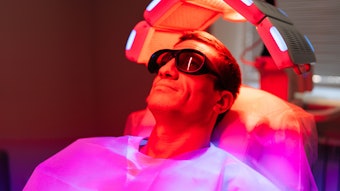
Sensitive skin is a phenomenon sweeping the skin care industry, with its prevalence reported at 50%–80% of the U.S. population depending on what report you read. So, what exactly defines sensitive skin in the mind of the client and consumer?
Is it fair skin that sunburns easily? This is photosensitive skin and not sensitive skin, but many consumers cannot distinguish between the two.
Is it skin that gets scaly easily? This is dry skin and not sensitive skin, but again consumers cannot distinguish.
Is it skin that stays red for a long time after injury? This is really healing skin and not sensitive skin, but the consumer cannot tell the difference.
It is this confusion that leads many to believe they have sensitive skin and purchase products marketed to this population. So, let’s address sensitive skin from a dermatologist’s perspective. This, too, is controversial, as no medical definition exists. Sensitive skin is a marketing term that consumers seem to understand, yet dermatologists do find this concept helpful in treating people who have skin issues.
Consumers with sensitive skin can either present with skin that appears normal to the eye or overt skin disease. Those with overt skin disease are sometimes easier to evaluate, since visual inspection can provide an idea of how to approach the problem. Invisible sensitive skin is a tremendous challenge as there is nothing to evaluate, except for information derived from questioning the consumer.
Skin Barrier Damage
The most common cause of sensitive skin that is easily visualized is damage to the skin barrier. This means that something has irritated the skin resulting in redness, flaking and tenderness. The consumer can easily visualize that something has happened due to the associated stinging, itching, burning and pain sensations. This could be scrubbing too hard with a wash cloth, using an exfoliating alpha hydroxy acid containing moisturizer or engaging into too many aggressive cosmetic procedures.
Sensitive skin can be a side effect of the overzealous consumer who engages in weekly microdermabrasion, lunchtime face peels and nightly retinoids. All of these procedures and products damage the skin barrier, which produces sensitive skin over time. The solution to the problem is to simply discontinue the damaging activities and let the sensitive skin self-resolve.
From a dermatologic standpoint, the three most common causes of sensitive skin are eczema, atopic dermatitis and rosacea. These three diseases nicely illustrate the three components of sensitive skin, which include barrier disruption, immune hyper-reactivity and heightened neurosensory response.

Eczema
Eczema is the most common cause of sensitive skin, but it is more than just flaky skin. It is flaky, dry skin accompanied by barrier disruption and the resulting inflammation, which makes the skin uncomfortable and sensitive. The most common cause of eczema is consumers using strong cleansers too often on the skin. This type of sensitive skin can be found on any body area, but is most common in areas where oil production is low, such as the upper back, lower arms and lower legs.
Decreasing the frequency of bathing, using cooler water and taking shorter baths can all stop barrier damage. Switching to a mild body wash from a stronger deodorant bar soap is also helpful. This type of self-induced sensitive skin is frequently seen in mature individuals who insist on bathing to the point of skin barrier damage. Prescription treatments for this type of sensitive skin includes topical corticosteroids, but many over-the-counter moisturizers for sensitive skin will incorporate botanical anti-inflammatory substances, such as allantoin, chamomile or green tea.
Atopic Dermatitis
Sensitive skin due to eczema is based only on physical barrier disruption, while the sensitive facial skin associated with atopic dermatitis is based both on a barrier defect and a hyperactive immune system. People with atopic dermatitis have eczema, hay fever and sometimes asthma. This means they have many allergies, not only to substances they inhale, but also to foods and skin care products. Their immune system is so hyperactive that they have allergies to substances at a much higher rate than the rest of the population. These individuals have sensitive skin exemplified by many skin product intolerances. Sensitive skin products for this population avoid irritating substances, and may undergo additional testing in individuals with atopic dermatitis to be sure the formulation is truly appropriate for sensitive skin.
Rosacea
Rosacea is an example of the third component of sensitive facial skin, which is heightened neurosensory response. Consumers with rosacea experience stinging and burning more frequently than the general population to minor irritants. This may be due to more sensitive nerve endings that produce more sensation.
Skin care products that most consumers can tolerate can cause intense burning in consumers with sensitive skin and rosacea. Further, consumers with rosacea also get facial flushing and blushing with minimal stimuli—hot air, cold air, sunlight or wind can cause the face to turn red. People with rosacea also seem to have very reactive blood vessels. For example, certain food substances, such as caffeine and alcohol, can induce a red face that will last for hours. This is why people with rosacea need to avoid coffee, tea, chocolate, wine and beer. Thus, sensitive skin products must also avoid producing any sensation on the skin, such as cooling or warming. This means rapid evaporation of the skin care product from the skin or the introduction of sensates, such as menthol, are not appropriate in sensitive skin products.
Sensitive skin products should improve the skin barrier, contain ingredients that have been tested for gentleness and avoid skin irritation. However, sensitive skin problems can still arise from even the best formulated products. Products selected for sensitive skin clientele should perform the following:
- Eliminate common allergens and irritants.
- Select a reputable manufacturer incorporating high-quality, pure ingredients free of contaminants.
- Choose well-preserved products to prevent spoilage.
- Avoid solvents, volatile vehicles, vasodilatory substances and sensory stimulators.
- Minimize the use of surfactants and select minimally irritating emulsifier systems.
There are some important guidelines to consider that may be helpful in minimizing problems for the sensitive skin consumer. Cleansing, moisturizing and color correcting are needed by all sensitive skin clientele, but these products should be chosen wisely by the skin care professional.

Cleansing. Sensitive skin consumers require basic hygiene, as the face and body must be cleansed. There is no doubt that synthetic detergent cleansers (syndets) provide the best skin cleansing while minimizing barrier damage. Bars based on sodium cocoyl isethionate appear to perform the best. There are some sensitive skin consumers with minimal sebum production, and a lipid-free cleanser is preferable because it can be used without water and wiped away. These products may contain water, glycerin, cetyl alcohol, stearyl alcohol, sodium laurel sulfate and occasionally propylene glycol. They leave behind a thin moisturizing film and can be used effectively in persons with excessively dry, sensitive or diseased skin.
Moisturization. After completing cleansing, the sensitive skin consumer requires moisturization. Moisturizers for sensitive skin should create an optimal environment for barrier repair, while not inducing any type of skin reaction. For example, the product should not contain any mild irritants. The best sensitive skin moisturizers are simple oil-in-water emulsions based on dimethicone containing the fewest ingredients possible. More ingredients create the potential for more problems. Anti-aging moisturizers with 15–30 botanical extracts should be avoided, as basic is better.
Color correction. Sensitive skin consumers also require recommendations on proper cosmetic selection. This can be a challenge, since cosmetic formulations change rapidly as dictated by the needs of fashion. The best method for evaluating problematic facial cosmetics is the provocative use test, performed by applying a 2 cm area of product lateral to the eye for five consecutive nights. This allows isolation of the cosmetic products one at a time on the most sensitive part of the face, which has the highest yield of uncovering the problem.
A Challenge
The definition and treatment of sensitive skin is a challenge. Sensitive skin can be improved by using a mild cleanser and a good moisturizer to optimize the skin barrier. Inciting allergic and irritant reactions should be avoided with adequate testing of the formulation in persons with sensitive skin. Finally, any substance that creates a sensation activating skin nerves should be avoided. These ideas address the barrier dysfunction, overactive immune system and heightened neurosensory awareness characteristic of sensitive skin.
Bathing with cool water and mild soap reduces skin barrier damage.
Basic formulations with gentle ingredients minimize irritation for sensitive skin consumers.












